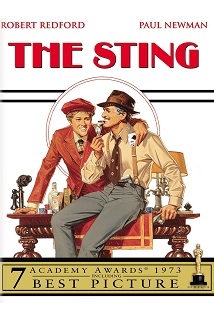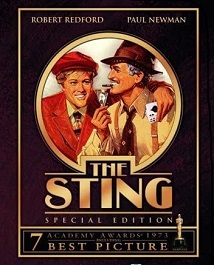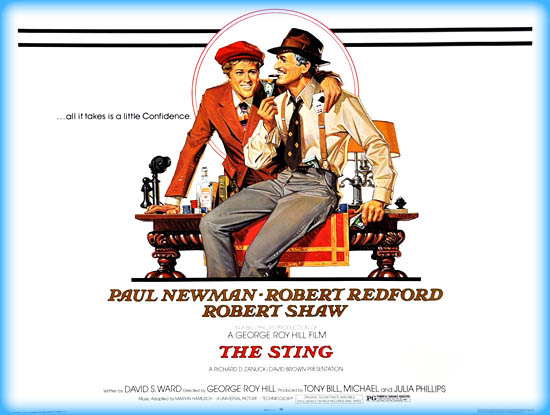The Sting
The Film
The Sting is a 1973 American film, set in September 1936, involving a complicated plot by two professional grifters, played by Paul Newman and Robert Redford, to con a mob boss, played by Robert Shaw. The film was directed by George Roy Hill, who had directed Newman and Redford in the western Butch Cassidy and the Sundance Kid. Created by screenwriter David S. Ward, the story was inspired by real-life cons perpetrated by brothers Fred and Charley Gondorff and documented by David Maurer in his 1940 book The Big Con: The Story of the Confidence Man.
The title phrase refers to the moment when a con artist finishes the ' play' and takes the mark's money. If a con is successful, the mark does not realize he has been cheated until the con men are long gone, if at all.
The film is played out in distinct sections with old-fashioned title cards drawn by artist Jaroslav 'Jerry' Gebr, the lettering and illustrations rendered in a style reminiscent of the Saturday Evening Post, an American magazine which was especially popular in the 1920s and 1930s. The film is noted for its anachronistic use of ragtime, particularly the melody 'The Entertainer' by Scott Joplin, which was adapted, along with others by Joplin, for the film by Marvin Hamlisch. The melody became a top-ten chart single for Hamlisch when released as a single from the film's soundtrack, and the film's success created a resurgence of interest in Joplin's work.
Released on Christmas Day 1973, The Sting was a massive critical and commercial success. It was hugely successful at the 46th Academy Awards, being nominated for ten Oscars and winning seven: Best Picture, Best Director, Best Film Editing, Best Original Screenplay, Best Scoring, Best Art Direction and Best Costume Design; Redford was also nominated for Best Actor. The film also rekindled Newman's career after a series of big screen flops. Regarded as having one of the best screenplays ever written, in 2005 The Sting was selected for preservation in the U.S. National Film Registry of the Library of Congress as being 'culturally, historically, or aesthetically significant.'
Writing
Screenwriter David S. Ward said that he was inspired to write The Sting while doing research on pickpockets, saying "Since I had never seen a film about a confidence man before, I said I gotta do this." Daniel Eagan explained: "One key to plots about con men is that film goers want to feel they are in on the trick. They don't have to know how a scheme works, and they don't mind a twist or two, but it's important for the story to feature clearly recognizable 'good' and 'bad' characters."
It took a year for Ward to correctly adjust this aspect of the script and to figure out how much information he could hold back from the audience while still making the leads sympathetic. He also imagined an underground brotherhood of thieves who assemble for a big operation and then melt away after the 'mark'.
Rob Cohen, subsequently director of action films such as The Fast and the Furious, years later told how he found the script in the slush pile when working as a reader for Mike Medavoy, a future studio head, but then an agent. He wrote in his coverage that it was "the great American screenplay and … will make an award-winning, major-cast, major-director film." Medavoy said that he would try to sell it on that recommendation, promising to fire Cohen if he could not. Universal bought it that afternoon, and Cohen keeps the coverage framed on the wall of his office.
David Maurer sued for plagiarism, claiming the screenplay was based too heavily on his 1940 book The Big Con, about real-life tricksters Fred and Charley Gondorff. Universal quickly settled out of court for $300,000, irking David S. Ward, who claimed he had used many nonfiction books as research material and had not really plagiarised any of them.
Writer/producer Roy Huggins maintained in his Archive of American Television interview that the first half of The Sting plagiarised the famous 1958 Maverick television series episode 'Shady Deal at Sunny Acres' starring James Garner and Jack Kelly.
Casting
Ward originally wrote Henry Gondorff as a minor character who was an overweight, past-his-prime slob, but once Paul Newman became associated with the movie, Gondorff was rewritten as a slimmer character and his part was expanded in order to maximize the second partnership of Newman and Redford. Newman had been advised to avoid doing comedies because he didn't have the light touch, but accepted the part to prove that he could handle comedy just as well as drama.
Jack Nicholson was offered the lead role but turned it down.
Newman signed on the film after the producers agreed to give him top billing, $500,000 and a percentage of the profits. Newman needed a hit considering his last five films that he had made prior to The Sting had been box-office disappointments.
In her 1991 autobiography 'You'll Never Eat Lunch in This Town Again', Julia Phillips stated that Hill wanted Richard Boone to play Doyle Lonnegan. Much to her relief, Newman had sent the script to Robert Shaw while shooting 'The Mackintosh Man in Ireland' to ensure his participation in the film. Philips's book asserts that Shaw was not nominated for a Best Supporting Actor Academy Award because he demanded that his name follow those of Newman and Redford before the film's opening title.
Shaw's character's limping in the film was authentic. Shaw had slipped on a wet handball court at the Beverly Hills Hotel a week before filming began and had injured the ligaments in his knee. He wore a leg brace during production which was hidden under the wide 1930s style trousers.
Principal Photography
Hill decided that The Sting would be reminiscent of movies from the 1930s, and watched films from that decade for inspiration. While studying '30s gangster films, Hill noticed that most of them rarely had extras. "For instance," said Hill as quoted in Andrew Horton's 1984 book 'The Films of George Roy Hill', "no extras would be used in street scenes in those films: Jimmy Cagney would be shot down and die in an empty street. So I deliberately avoided using extras."
Along with art director Henry Bumstead and cinematographer Robert L. Surtees, Hill devised a colour scheme of muted browns and maroons for the film and a lighting design that combined old-fashioned 1930s-style lighting with some modern tricks of the trade to get the visual look he wanted. Edith Head designed a wardrobe of snappy period costumes for the cast, and artist Jaroslav Gebr created inter-title cards to be used between each section of the film that were reminiscent of the golden glow of old Saturday Evening Post illustrations, a popular publication of the 1920s and 1930s.
The movie was mainly filmed on the Universal Studios backlot. Other scenes were shot in Wheeling, West Virginia, the Santa Monica pier's carousel, in Santa Monica, California, in Pasadena, California and in Chicago at Union Station and the former LaSalle Street Station prior to its demolition. Co-producer Tony Bill was an antique car buff who helped round up several period cars to use in the film. One of them was his own one-of-a-kind 1935 Pierce-Arrow, which served as Lonnegan's private car.
Reception
The Sting received exceptionally good reviews and was a box-office smash in 1973–1974, taking in more than US$160 million ($800 million today). As of August 2018, it is the 20th highest-grossing film in the United States adjusted for ticket price inflation.
Roger Ebert gave the film a perfect four out of four stars and called it "one of the most stylish movies of the year." Gene Siskel awarded three-and-a-half stars out of four, calling it "a movie movie that has obviously been made with loving care each and every step of the way." Vincent Canby of The New York Times wrote that the film was "so good-natured, so obviously aware of everything it's up to, even its own picturesque frauds, that I opt to go along with it. One forgives its unrelenting efforts to charm, if only because The Sting itself is a kind of con game, devoid of the poetic aspirations that weighed down Butch Cassidy and the Sundance Kid."
Variety wrote, "George Roy Hill's outstanding direction of David S. Ward's finely-crafted story of multiple deception and surprise ending will delight both mass and class audiences. Extremely handsome production values and a great supporting cast round out the virtues." Kevin Thomas of the Los Angeles Times called it "an unalloyed delight, the kind of pure entertainment film that's all the more welcome for having become such a rarity." John Simon wrote that The Sting as a comedy-thriller "works endearingly without a hitch".[23]
In 2005, the film was selected for preservation in the United States National Film Registry by the Library of Congress as being 'culturally, historically, or aesthetically significant'. The Writers Guild of America ranked the screenplay No 39 on its list of 101 Greatest Screenplays ever written.


Cast
Paul Newman as Henry "Shaw" Gondorff
Robert Redford as Johnny "Kelly" Hooker
Robert Shaw as Doyle Lonnegan
Robert Earl Jones as Luther Coleman
Charles Durning as Lt. William Snyder, Joliet P.D.
Ray Walston as J.J. Singleton
Eileen Brennan as Billie
Harold Gould as Kid Twist
John Heffernan as Eddie Niles
Dana Elcar as FBI Agent Polk, aka "Hickey"
Jack Kehoe as Erie Kid
Dimitra Arliss as Loretta Salino
James J. Sloyan as Mottola
Charles Dierkop as Floyd (Lonnegan's bodyguard)
Lee Paul as Lonnegan's bodyguard
Sally Kirkland as Crystal
Avon Long as Benny Garfield
Arch Johnson as Combs
Ed Bakey as Granger
Brad Sullivan as Cole
John Quade as Riley
Larry D. Mann as Clemens (the train conductor)
Leonard Barr as Burlesque House Comedian
Paulene Myers as Alva Coleman
Joe Tornatore as Black Gloved Gunman
Jack Collins as Duke Boudreau
Tom Spratley as Curly Jackson
Kenneth O'Brien as Greer
Ken Sansom as Western Union Executive
Ta-Tanisha as Louise Coleman
William "Billy" Benedict as Jimmy
Soundtrack
The soundtrack album, executive produced by Gil Rodin, included several Scott Joplin ragtime compositions, adapted by Marvin Hamlisch. According to Joplin scholar Edward A. Berlin, ragtime had experienced a revival in the 1970s due to several separate, but coalescing events:
Inspired by Schuller's recording,[clarification needed] Hill had Hamlisch score Joplin's music for the film, thereby bringing Joplin to a mass, popular public.
"Solace" (Joplin) – orchestral version
"The Entertainer" (Joplin) – orchestral version
"The Easy Winners" (Joplin)
"Hooker's Hooker" (Hamlisch)
"Luther" – same basic tune as "Solace", re-arranged
by Hamlisch as a dirge
"Pine Apple Rag" / "Gladiolus Rag" medley (Joplin)
"The Entertainer" (Joplin) – piano version
"The Glove" (Hamlisch) – a Jazz Age style number; only a short
segment was used in the film
"Little Girl" (Madeline Hyde, Francis Henry) – heard only as
a short instrumental segment over a car radio
"Pine Apple Rag" (Joplin)
"Merry-Go-Round Music" medley; "Listen to the Mocking Bird",
"Darling Nellie Gray", "Turkey in the Straw" (traditional)
– "Listen to the Mocking Bird" was the only portion of this
track that was actually used in the film, along with a segment of "King
Cotton", a Sousa march, a segment of "The Diplomat", another
Sousa march, a segment of Sousa's Washington Post March, and a segment
of "The Regimental Band", a Charles C. Sweeley march, all of
which were not on the album. All six tunes were recorded from the Santa
Monica Pier carousel's band organ.
"Solace" (Joplin) – piano version
"The Entertainer" / "The Ragtime Dance" medley (Joplin)
